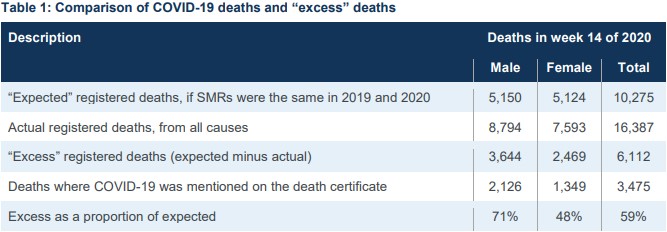Insight
There are an increasing number of data points showing that the deaths being counted for Covid19 around the world are a serious undercount of the actual deaths caused by the disease. Today I’m showing two fairly dramatic ones. First, in England and Wales the total deaths in a week were around 60% higher than normal – but only around half of those extra deaths mentioned Covid19 on the death certificate. And in New York, an extra 3,700 deaths were added to the count of deaths there by including deaths that were presumed to be from the virus, but were never tested.

In England and Wales, the Office of National Statistics (ONS) releases a weekly count of deaths, based on death certificates. The latest one (for the week ending 3 April) shows over 6,000 extra deaths compared with previous years. That’s (sadly) not surprising. But the surprise is how many more deaths there were than mentioned Covid19 on the death certificate. And the number of deaths reported in the daily reports around the world (my research suggests around 2,300 for that period) will be even lower, as in the UK, only deaths in hospital with a positive test for Covid19 are counted.
This blog post explains further.
…ONS figures by actual date of death (death occurrence) tend to be higher than the GOV.UK figures for the same day. This is because:
- We include all deaths where COVID-19 was mentioned on the death certificate, even if only suspected: the GOV.UK figures are only those deaths where the patient had a positive test result
- We include deaths that happened anywhere in England and Wales, for example some might be in care homes: the GOV.UK figures are only those that happened in hospital.
So if you are looking at UK death reports from Covid19, the actual excess deaths because of Covid19 are probably at least double those being reported on a daily basis.
And New York has just released a new count of deaths which now includes everyone who has been presumed to die of the virus, even if they were never tested.
New York City, already a world epicenter of the coronavirus outbreak, sharply increased its death toll by more than 3,700 victims on Tuesday, after officials said they were now including people who had never tested positive for the virus but were presumed to have died of it.
The new figures, released by the city’s Health Department, drove up the number of people killed in New York City to more than 10,000, and appeared to increase the overall United States death count by 17 percent to more than 26,000.
This article from Bloomberg points out that many of the extra people (who weren’t tested) died inside hospital emergency rooms before tests could be carried out.
The city’s Health Department published official statistics Tuesday afternoon reporting 6,589 confirmed Covid-19 deaths as of Monday at 4 p.m. The data released Tuesday showed among the newly counted victims, 60% died inside hospital emergency rooms before test results could confirm a diagnosis. Another 22% died at home, 18% in nursing homes or hospice, and less than 1% were dead on arrival at hospitals.
It is almost impossible for an overwhelmed health system to properly capture the full extent of the Covid19 toll – the Economist last week showed a number of similar examples from Italy and Spain. A country in the midst of this pandemic is almost certainly materially undercounting its toll.
Link
This link looks at US geographic data to see if there is a common factor with which localities have been more likely to comply with social distancing. They tried quite a few different factors, to discover that attitudes towards climate change are the strongest predictor of social distancing behaviour.
In fact, attitudes toward climate change are one of the strongest and most robust predictors of social distancing behavior. In the full model I find that an increase of 10 percentage points in the share of residents who do not agree that global warming is happening is associated with a 1 point drop in the county’s social distancing grade — which essentially means shifting from, say, a C to a B- in social distancing behavior.
The same results apply no matter how I run the analysis, and they apply to just about every question asked in the Climate Change in the American Mind survey. In the places where residents don’t think global warming is real, where they don’t believe humans are responsible, where they don’t think citizens have a responsibility to act, residents are also failing to change their behavior during the coronavirus crisis.
Respect for science, and belief in the value of community action are likely to drive both social distancing behaviour in a pandemic, and an understanding of the impacts of climate change and the need for citizens to act.
Life Glimpse
The weather in Sydney this autumn continues to be glorious, and I continue to be grateful that we are able to go outside for exercise – a walk or a run. Today was a classic clear blue Australian sky, mid 20s temperature. Increasingly people are dodging off the path as they come the other way, and we are lucky that our local park has lots of space around the path to keep dodging out of the way.
Bit of Beauty
Today’s bit of beauty is a new approach to the crème brulée cupcake. This time with the use of the classic blow torch approach. They have all been eaten now, but they were delicious!


“attitudes towards climate change are the strongest predictor of social distancing behaviour” Darwininan selection operating on an incredibly fast time scale?
I find it cruel to show a photograph of most delicious blow torched cupcakes. They have been eaten
with gusto I hope. Enjoy making them and eating them.
Never thought there is a connection between those who do not believe in Climate Change and Corona
Virus. love Marta
Great point about underreported deaths. Presumably the number will be even higher given there will be fewer deaths from other causes right now, as a result of people staying home and social distancing.
That also means that the number of cases is grossly underreported, since the latest figures on today’s WHO report imply a case fatality rates in the UK of nearly 13%.
Good point Andrew that other deaths should be even lower (eg car accidents), and even normal flu. In the UK, Covid19 tests are 25% positive, which does imply they are only testing very sick people.
Virtual cakes are somewhat disappointing. No wonder people seems to be cooking more so we get the real thing.
I do look at the stats given in various daily updates and the concept of comparing apples and pears comes to mind. I guess they are an approximation but so many variables between countries regarding testing and reporting.